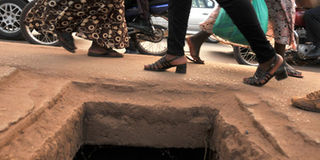Open manholes: The graves ready to devour you alive

Pedestrians walk past an open manhole near clock tower in Kampala.
What you need to know:
Take caution. When walking, riding or even driving in the city, one ought to be careful not to fall in the gaping manholes
A few months ago, I had the misfortune of landing in an open manhole that left me with a bruised knee and a limp for a few days.
And I would bet, I am just a small fraction of the many Ugandans that have suffered because of these gaping calamities in our city. These manholes are not just a hazard to us, but also reflect badly on the visitors that come into the country.
Initially, I took it upon myself to note every point that I had an open manhole. I, however, lost count, because they were too many for me to even keep up with. Along the street from Jinja road traffic lights to Oasis and Garden City shopping malls, there are gapping manholes staring back at you; at least after every five steps.
The manholes on that route are all uncovered, straight up to Fairway Hotel roundabout. These are an added hazard to the citizens of this town on top of the already existent potholes, and dimly lit streets.
Why they are open
Often, the authorities have attributed these to the thieves, who they say rob the manhole covers to obtain the steel materials on the inside of these concrete covers.
Technically, the responsibility to have these covered up would fall on the authorities such as Kampala Capital City Authority (KCCA), but like Michael Pande , a council member of the Ugandan Institute of Professional Engineers, explains, these manholes do not necessarily belong to the local authority.
“We have two types; the inspection chambers and the storm drains, which are commonly referred to as the manholes. The inspection chambers are owned by such organisation as National Water and Sewerage Corporation (NWSC), or telecom companies, while the manholes may carry the sewer system of the city,” he explains. These are labelled with the company initials to help differentiate them.
Samuel Apedel, the public relations manager at the National Water and Sewerage Corporation says the sewage channels, which are what the authority deals with, are always sealed.
“Those can never be left open, because if someone fell in, there are less chances of survival. The ones that are open are the storm drains that are the responsibility of KCCA.
Pande explains that as a city that is developing, we still have a long way to go as far as the infrastructural aspect is concerned.
He further explains that the inspection chambers are for purposes of routine checking of their services. It is because of this that this particular type of manhole cannot be closed off permanently.
“Technically, the solution would be getting permanent covers, but then, this is impossible, because the company has to do routine checks on their systems, which make the closure of these chambers temporarily. The biggest problem still remains the thieves that steal these covers,” he adds.
The impact
The first major impact is the health hazard that comes with one falling into these manholes. People flash all sorts of things in the sewers, including nails, bottles, or any dangerous objects that could harm you. Cuts from these could also result in catching tetanus.
The metals on these covers are also rusty and can be harbouring disease-causing germs.
Security also becomes an issue of concern because the thugs that rob people at night hide inside these manholes.
“In developed countries, the sewer system is not even supposed to be known by the public for security purposes. That is why having these manholes open is very dangerous, not just to the citizens, but also to the state of security,”Pande adds.
According to the 2013 Annual Crime and Traffic/Road Safety Report, the emergency rescue cases from pits, sewers, trenches and drainage were 126, with 57 of these being rescued and 41 bodies being retrieved from these drainage systems.
What makes these manhole covers prone to theft?
According to Michael Pande, a member of the Ugandan Institute of Professional Engineers, traditionally, these manhole covers were made of steel that does not rust easily. The steel is meant to make these covers thick enough so that cars can move over them without breaking them or them collapsing in.
“This is where the problem comes from. Those individuals that carry away these covers do not do it for malicious damage, but rather for the steel bars inside these covers,” he explains.
“Steel is sold in kilogrammes, and it is very expensive. It is mostly sold at construction sites, or at the steel recycling companies,” he adds.
Normally, these covers are simply placed over the manhole, which makes carrying them away by the thieves very easy.
Pande explains that the safer alternative would be putting hinges on the cover, so that carrying them away becomes difficult.
“However, when the hinges get in contact with water, they rust, and this can cause the covers to close permanently. So it makes no sense to invest in something that cannot last,” he adds.
When these covers are stolen, replacing them continuously becomes very expensive for the company, which explains why many of these remain gaping for a long time. This is probably where the need to have a mindset change amongst the masses.
“Many people are not stealing these covers because they are poor, but because they have ready buyers waiting on the other end to buy these solid metals from them,” Pande explains.
What authorities are doing about it
Ram

A Kampala Capital City Authority employee works on sewer system in the city.
i Farah, the chief technical officer, MTN Uganda, says the company has invested heavily to put up network infrastructure across the city and the country with inspection chambers (manholes) complete with covers.
“From time to time, we have got incidences of cover thefts, leading to network vandalism. In such instances, we duly alert the responsible security organs who take action. As part of our precautionary measures, we have sealed/welded our covers to deter easy removal. This has significantly reduced on the theft incidences. However, we appeal to the public to report such occurrences to the relevant stakeholders like Police, Kampala Capital City Authority and MTN Uganda,” he adds.
“We have more than 80 manholes all over the country and yes, we have had cases where the manhole covers are stolen. In such cases, we work closely with our fibre maintenance partners to ensure safeguard of the manholes and their replacement,” Sandor Lyle Walusimbi, public relations manager at Airtel Uganda, explains.
Michael Pande, a member of the Uganda Institute of Professional Engineers, explains that the one solution could be in having those that are lockable, but that does not guarantee that a thief wont device means to unlock it, and carry it away.
In countries like France, the lockable system is what is used, and they use screwing machines to unlock them.
“The companies here could resort to using the square ones that have hinges. These, however, work best when the manhole protrudes high above the ground so that when it rains, not much soil gets caught in the hinges. The soil makes it very difficult to open them,” Pande explains,”
The other solution would be using construction material known as reinforced plastic.
“It is called GRP - Glass Fiber Reinforced Plastics. These are every strong, and they are built in a way that makes them comfortable and safe to walk over without slipping,” Pande adds. The only way this kind of cover would be stolen would be by breaking it. These, however, carry a hefty price tag.
There would also need to be combined efforts between the companies that own these manholes and the law enforcement officers, so that anyone caught with these stolen covers is brought to justice.
Kampala Capital City Authority speaks out
Peter Kauju, the Kampala Capital City Authority (KCCA) public relations officer, had this to say:
There are several manholes used by different entities such as KCCA, National Water Sewerage Corporation and others by telecoms for their cables. We continue to witness cases of vandalism of these installations.
This has not only cost us as government in terms of money, but also caused accidents, especially when it rains. They have been vandalised because of the steel rods in the covers.
But we have beefed up surveillance and prosecution of culprits. A massive replacement drive is ongoing and we are working to design and shape stone material to check the problem. In Kampala, vandals can steal anything but we hope the material, which is under procurement, will help address the problem.




